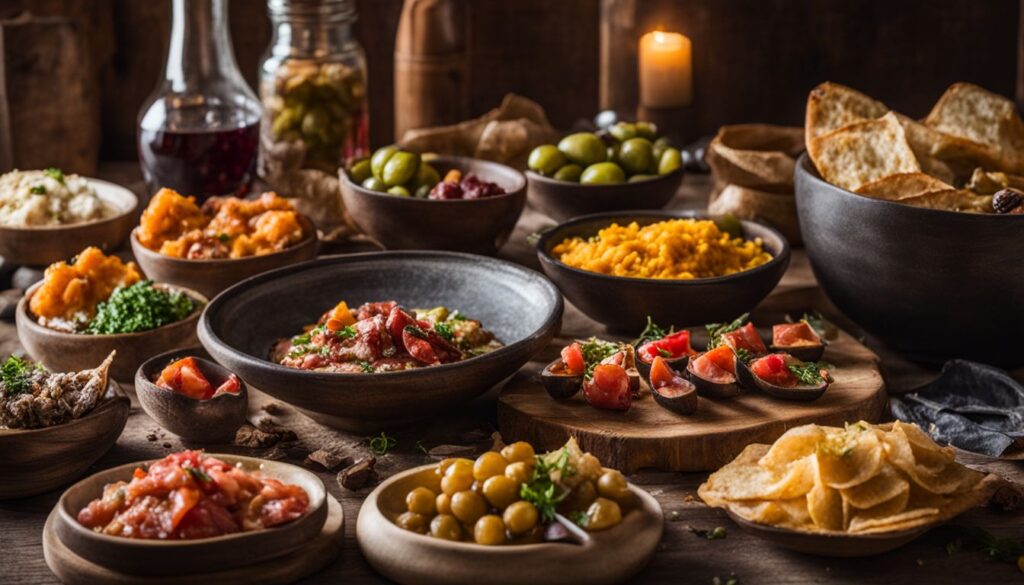Spanish cuisine has long been celebrated for its bold flavours, rich cultural heritage, and passionate approach to food. Among its many iconic dishes, tapas stand out as a symbol of Spanish culinary creativity and social dining. Over time, tapas have evolved to incorporate international influences, giving rise to an exciting new trend: Spanish tapas fusion. Let’s embark on a culinary journey to explore how this fusion blends diverse flavours worldwide while paying homage to traditional Spanish roots.
The Origins of Spanish Tapas
A Brief History of Tapas
Before delving into the world of fusion, it’s essential to understand the origin of tapas. The word “tapas” comes from the Spanish verb “tapar,” meaning “to cover.” Historically, tapas were small plates or snacks placed over drinks to prevent flies or dust from contaminating them. These small plates often included bread, cheese, or cured meats. As time passed, tapas became integral to Spanish culture, encouraging people to gather and share various dishes over drinks and lively conversation.
Tapas reflect Spain’s rich regional diversity, with each area contributing unique flavours and ingredients. Tapas offers various flavours representing Spanish cuisine’s heart and soul, including Andalusian gazpacho or Basque pintxos.
The Rise of Tapas Fusion
Blending Tradition with Innovation
As the world became more interconnected, so did its culinary traditions. Chefs worldwide began experimenting with traditional Spanish tapas, infusing them with ingredients and techniques from other cultures. This blending of flavours gave birth to tapas fusion, a creative culinary movement that pushes the boundaries of Spanish cuisine while honouring its deep-rooted traditions.
Tapas fusion can take many forms, from Asian-inspired tuna tartare served on crispy tortillas to Mediterranean flavours with classic Spanish ingredients. These dishes reflect the innovation of modern cuisine while preserving the core elements that make tapas so beloved.
D’ La Rosa is a name that may come up in discussions about tapas fusion. It is known for its creative approach to blending traditional Spanish tapas with contemporary influences. Their dishes showcase how daring combinations of flavours can lead to exciting culinary experiences.
Signature Dishes in Tapas Fusion
Gambas Al Ajillo with a Thai Twist
One example of tapas fusion is the traditional gambas al ajillo, or garlic shrimp, which typically features succulent shrimp cooked in olive oil with garlic and chilli. In a fusion twist, chefs may add lemongrass, coconut milk, or Thai spices, transforming the dish while retaining its Spanish essence. The result is a dish that offers both the comforting familiarity of Spanish cuisine and the exciting complexity of Thai flavours.
Tacos de Paella
Tacos are synonymous with Mexican cuisine, but when combined with Spain’s famous paella, they create an irresistible fusion dish. Imagine saffron-infused rice and seafood, a hallmark of paella, nestled inside soft taco shells and garnished with fresh cilantro and lime. This inventive fusion allows two beloved culinary traditions to merge into something new, exciting, and delicious.
Croquetas with a Korean Kick
Croquetas, a traditional Spanish dish typically filled with ham or cheese, take on a new personality in tapas fusion. In this variation, the croquettes are stuffed with kimchi or Korean-style beef, offering a delightful tang and spice that pairs beautifully with the creamy, savoury filling. This combination of textures and flavours exemplifies the best of tapas fusion.
The Impact of Fusion on Spanish Tapas Culture
Respecting Tradition While Embracing Change
Tapas fusion is more than a trend—it reflects a cultural shift in how we approach food. In today’s globalised world, people are increasingly open to experimenting with new flavours and combining different culinary traditions. This openness has allowed tapas fusion to flourish, with chefs continuing to explore new ways to blend cultures and flavours on the plate.
However, it is essential to strike a balance between innovation and tradition. Tapas fusion should not overshadow the authenticity of classic Spanish tapas but rather celebrate the versatility of the cuisine. The goal is to honour Spanish heritage while embracing new influences, resulting in comfortable and surprising dishes.
De La Rosa, for example, ensures that while its fusion dishes incorporate international flavours, they maintain the authenticity of Spanish tapas. By doing so, they create an experience that is both modern and deeply rooted in tradition.
The Social Aspect of Tapas Fusion
A Shared Experience
Whether traditional or fusion, tapas have always been about more than just the food—they represent the art of sharing. Tapas culture encourages people to gather, share small plates, and engage in conversation, fostering a sense of community. Tapas Fusion continues this tradition, inviting people from different backgrounds to come together, try new flavours, and enjoy a shared culinary adventure.
Restaurants specialising in tapas fusion often reflect this social aspect in their atmosphere, featuring communal seating and a relaxed dining environment. Whether you’re savouring classic Spanish patatas bravas with a spicy twist or trying a fusion hummus inspired by Spanish flavours, the essence of tapas lies in the joy of sharing food and experiences.
Conclusion
Spanish tapas fusion offers an exciting and delicious way to explore the blending of traditional flavours with modern culinary innovations. By bringing together the rich heritage of Spanish cuisine with global influences, tapas fusion invites us on a journey where tradition meets creativity on the plate. Whether you’re a fan of the classics or eager to try something new, the world of tapas fusion offers something for everyone.
Next time you sit down to enjoy tapas, consider venturing into fusion territory—you may discover a new favourite dish. The beauty of tapas, whether traditional or fusion, lies in the joy of sharing, connecting with others, and celebrating the endless possibilities of food.







